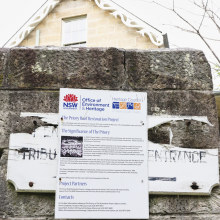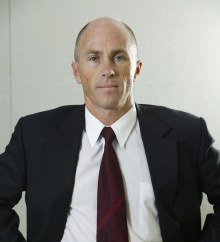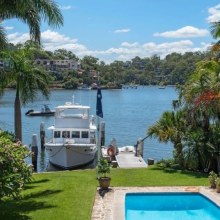Few apartments help keep land prices high and limit the population to just 13,000, which the council’s last housing plan forecast would decline between now and 2036.
The use of conservative growth forecasts is a way for councils to avoid approving extra housing, according to Tony Richards, a former Reserve Bank of Australia head of economic research.

NSW Heritage and Hunters Hill Council opposed a plan for a restaurant in the colonial-era building. Natalie Boog
(Hunters Hill mayor Zac Miles didn’t respond to a request for comment on the forecast.)
Broken windows
The Priory hasn’t been occupied since 2003, when the NSW Health Department moved out, leaving it to the council’s care. On a recent afternoon, a few dogs and their walkers strolled past, oblivious. Three young children played with their carers in an adjacent playground.
The building’s broken lattice work, boarded-up windows, and a broken door were hidden from view by a copse of trees, including tropical palms planted when it housed the mentally ill. The garden looked ignored. The paintwork was years old.
On the street, on the other side of an old wire fence, a sign erected by the council said: “Council’s vision for the property includes restoring it and establishing a multipurpose cultural facility, possibly including: art gallery/exhibition space, a base for heritage walks, an outdoor space for activities such as open gardens and weddings, community meeting facilities, and a museum.”

CommSec chief economist Craig James, seen in 2005, opposes the project. Louie Douvis
Hunters Hill families, who earn twice the national average, like their enclave exclusive.
One of the leading voices at a public meeting last October to discuss Colosi’s plan was Craig James, an economist at Commonwealth Bank of Australia’s stockbroking arm. Like most residents, he complained the proposal was too ambitious.
“We would all like to see it utilised by the community in a sustainable way in a residential area safe for children,” he told me.
Subsidies for silence
Colosi’s plan to build a glass-walled pavilion in the building’s derelict courtyard requires 400 seats to cover the $7 million renovation cost, he says. James, who analyses capitalism for a living, argues government subsidies would make a smaller eatery viable.
Other Colosi opponents identified in council briefing papers include a property buyers’ agent, a podiatrist, and a financial analyst. The critics’ main complaint is car parking and traffic, even though there is plenty of the former and little of the latter.

Hunters Hill Council has forecast a decline in population up to 2036.
One resident alleged the restaurant’s lights could hurt nocturnal hunting by powerful owls (the largest of the species in Australia) nearby, although didn’t mention Huntleys Cove has almost as much parkland as housing. Another complained about potential noise from speeches and music. A 10.30pm curfew would be imposed, to ensure the fun doesn’t run too late.
Hunters Hill Council never rejected the proposal. Instead, with the support of Heritage NSW, it commissioned a damning assessment that accused Colosi of “overdevelopment”.
That report went to a regional planning panel – which is meant to keep a check on anti-development councils – chaired by a former Liberal politician, Peter Debnam. Citing community opposition and the council’s arguments, Debnam’s three-person panel rejected the proposal on December 1.
Miles, the mayor, said he wants Colosi to open a restaurant in the Priory. The council has offered to waive its fees if Colosi resubmits a more modest plan, he said. Colosi hasn’t indicated if he will take up the offer.
